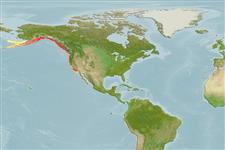>
Perciformes/Scorpaenoidei (Scorpionfishes) >
Sebastidae (Rockfishes, rockcods and thornyheads) > Sebastinae
Etymology: Sebastes: Greek, sebastes = august, venerable (Ref. 45335); paucispinis: From the Latin pauci and spinus, connoting 'few' and 'spine' (Ref. 27436).
More on author: Ayres.
Environment: milieu / climate zone / depth range / distribution range
Ecologia
marino associati a barriera corallina; distribuzione batimetrica 0 - 476 m (Ref. 27437). Subtropical; 65°N - 31°N
Eastern Pacific: Stepovak Bay, Alaskan Peninsula to Punta Blanca, Baja California, Mexico.
Length at first maturity / Size / Peso / Age
Maturity: Lm 48.0, range 36 - ? cm
Max length : 91.0 cm TL maschio/sesso non determinato; (Ref. 2850); peso massimo pubblicato: 9.6 kg (Ref. 4690); Età massima riportata: 50 anni (Ref. 75794)
Spine dorsali (totale): 13 - 15; Raggi dorsali molli (totale): 13-16; Spine anali 3; Raggi anali molli: 8 - 10; Vertebre: 26. A large rockfish with weak head spines - nasal and parietal spines usually absent, preocular, supraocular, postocular, tympanic, coronal and nuchal spines absent (Ref. 27437). Lower jaw long, thickened, with no real symphyseal knob and projects past upper jaw; maxillary extends to behind the eye; parietal ridges parallel (Ref. 27437). Caudal slightly indented (Ref. 6885). Olive orange to burnt orange or brown in color (Ref. 27437). Branchiostegal rays: 7 (Ref. 36715).
Adults found over rocky reefs, but also common on open bottoms to about 320 m (Ref. 2850). Juveniles are pelagic and settle in near shore nursery areas, then move to deeper habitats (Ref. 36715). Young form schools (Ref. 2850). Feed mainly on fishes, including other rockfishes (Ref. 2850). Ovoviviparous, with planktonic larvae (Ref. 36715, 6885, 34817). Validated age by radiometry is 37 yrs (Ref. 75794). A famous sport fish throughout its range (Ref. 2850). Flesh is of excellent quality when kept chilled (Ref. 27436). Sold with other rockfish species (Ref. 27436).
Eschmeyer, W.N., E.S. Herald and H. Hammann, 1983. A field guide to Pacific coast fishes of North America. Boston (MA, USA): Houghton Mifflin Company. xii+336 p. (Ref. 2850)
IUCN Red List Status (Ref. 130435)
Human uses
Pesca: scarso interesse commerciale; Pesce da pesca sportiva: si; Acquario: Acquari pubblici
Informazioni ulteriori
CollaboratoriImmaginiStamps, Coins Misc.SuoniCiguateraVelocitàModalità di nuotoArea branchialeOtolithsCervelliVista
Strumenti
Special reports
Download XML
Fonti Internet
Estimates based on models
Preferred temperature (Ref.
123201): 4.5 - 8.9, mean 5.9 °C (based on 177 cells).
Phylogenetic diversity index (Ref.
82804): PD
50 = 0.5000 [Uniqueness, from 0.5 = low to 2.0 = high].
Bayesian length-weight: a=0.01000 (0.00499 - 0.02004), b=3.09 (2.92 - 3.26), in cm total length, based on LWR estimates for this Genus-body shape (Ref.
93245).
Trophic level (Ref.
69278): 3.5 ±0.46 se; based on food items.
Resilienza (Ref.
120179): Basso, tempo minimo di raddoppiamento della popolazione 4.5 - 14 anni (tm=4; tmax=50; Musick et al. 2000 (Ref.
36717)).
Prior r = 0.25, 95% CL = 0.17 - 0.38, Based on 1 stock assessment.
Fishing Vulnerability (Ref.
59153): High vulnerability (63 of 100).
Climate Vulnerability (Ref.
125649): Moderate to high vulnerability (45 of 100).
Nutrients (Ref.
124155): Calcium = 11 [4, 34] mg/100g; Iron = 0.34 [0.13, 0.81] mg/100g; Protein = 19.2 [18.0, 20.4] %; Omega3 = 0.4 [0.2, 1.0] g/100g; Selenium = 66.5 [22.9, 204.1] μg/100g; VitaminA = 52.6 [18.2, 150.1] μg/100g; Zinc = 0.446 [0.224, 0.863] mg/100g (wet weight);
